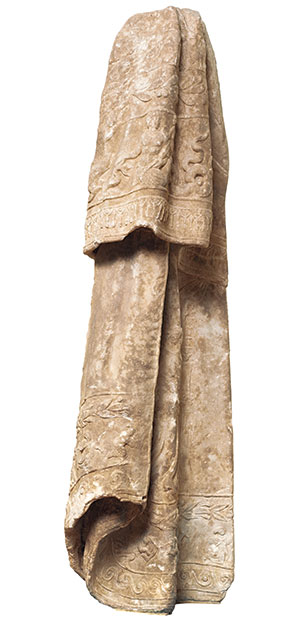Exhibit of the month
Benevolent deities of the sea …
Fragment of a relief himation with the representation of a marine thiasos
National Archaeological Museum
Sculpture Collection, inv. no 1737
Provenance: found in the Temple of the Great Goddesses, Demeter and Despoina, at Lykosoura in Arcadia
Dimensions: Height: 1.13 m
Date: early 2nd c. BC
Display location: Sculpture Collection, Room 29
The himation forms part of the garment of Despoina from the cult sculptural group of the temple, a work created by the Messenian sculptor Damophon. The sculpture is decorated with relief motifs arranged in parallel rows: from top down are depicted eagles alternating with thunderbolts, olive or laurel branches, a band with a marine thiasos, Nikai holding incense burners, human figures wearing animal masks and dancing during mystery rituals.
The marine thiasos consists of a procession of half-naked Nereids riding on seahorses, dolphins and a fish-tailed Triton with a rudder on his shoulder. The scene draws its inspiration from the famous work by the 4th-century BC sculptor Scopas, that was carved in the round and depicted the Nereid Thetis delivering the weapons to her son Achilles and Poseidon, surrounded by real and imaginary sea creatures.
The Nereids, sea nymphs in human form, constituted an individual iconographic theme during the Classical period. The Nereid statue riding a dolphin used as acroterion on a temple in the Athenian Agora is a case in point. Nonetheless, the theme of the marine thiasos was particularly popular during the Hellenistic and the early Imperial period in compositions of decorative character. Soon, the jubilant marine thiasos acquired eschatological content as it was believed that the Tritons and the Nereids accompanied the deceased, like Achilles, to the Elysian Fields, proclaiming to the living the joy that awaits them in the afterlife, therefore it was extensively used in the decoration of sarcophagi .
The Nereids and Triton — the primordial sea demon who in art and poetry is multiplied (Tritones) so as to become the male equivalent to the Nereids and acquires his female counterparts, the Tritonides — but also other benevolent deities of the sea were familiar with the depths and the secrets of waters, could forecast the weather, calmed down the windstorms and intervened to stop the tempests. They assisted seafarers so as to avoid the unforeseen hazards of the high seas, such as the Argonauts whom they helped to cross the channel between Scylla and Charybdis, or Odysseus who, aided by Leukothea that gave him her veil to offer him protection, reached the island of the Phaeacians safely. They accompanied Europa in her voyage to Crete together with Zeus who, transformed into a bull, carried her on his back, but also Theseus who dived to the submerged palace of his father Poseidon. Hence, they are the good-natured guides and rescuers of seafarers, similar to Panagia Gorgona (Virgin Mary the Mermaid) of the modern Greek tradition.
Dr Chrysanthi Tsouli
Bibliography:
G. Dickins, Damophon of Messene – II, BSA 13, 1906-1907, 363, pl. 14.
A. Wace, The veil of Despoina, AJA 38, 1934, 107-111.
A.F. Stewart, Skopas of Paros, Park Ridge, N.J. 1977, 99-101.
N. Kaltsas, National Archaeological Museum. The Sculpture, Athens – Los Angeles 2002, 280, cat. no. 586.
Aston E., Mixanthrôpoi. Animal-human hybrid deities in Greek Religion, Kernos Suppl. 25, Liege 2011, 299-301, 240-41, fig. 30.
M.-X. Garezou et al (eds), Nautilus: Navigating Greece, Athens 2014, 227-229, cat. no. 72 (E. Vlachogianni).
General bibliography:
S. Lattimore, The Marine Thiasos in Greek Sculpture, Los Angeles 1976.
J. Barringer, Divine Escorts, Nereids in Archaic and Classical Greek Art, Ann Arbour 1995.
G. Muth, Gegenwelt als Gluckswelt – Gluckswelt als Gegenwelt? Die Welt der Nereiden, Tritonen, und Seemonster in der romischen Kunst, in T. Holscher (ed.), Gegenwelt zu den kulturen Griechenland und Rom in der Antike, München – Leipzig 2000, 467-97.


